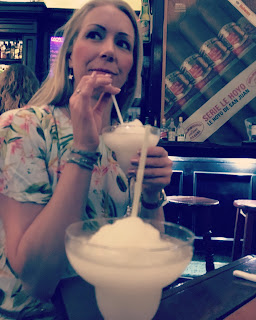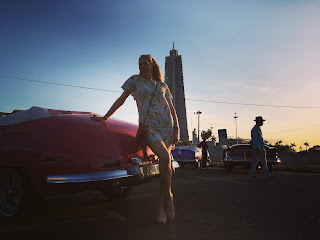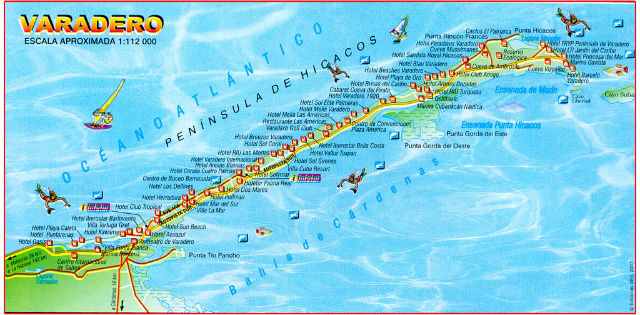 |
| Arriving in Cuba (Andy's case - mine's WAY bigger) |
Our trip to Cuba kicks off with a two-hour delay at Gatwick; as soon as I clock the uber-glam trolley dollies on our Virgin Atlantic flight I've sussed out why: it must've taken them at least that long to get their make-up on. And that's just the fellas. That's not a criticism - I have nothing but admiration for any gal (or guy) who can convincingly contour their face without looking like a deranged zebra. That's skills right there.
The nine-hour flight is a breeze - great service (by which I mean free-flowing booze with no judgemental frowns), great food (including delicious Gu desserts, packets of Skittles and an abundance of Love Hearts, which send sweet-toothed Andy into raptures). We even make up almost an hour of the delay.
Stepping onto Cuban soil - super-excited, sunnies at the ready - we're greeted with...rain. Of biblical proportions. Have a word! We didn't sign up for this. April is Cuba's winter, but still boasts average temperatures of 30 degrees; the rainy season doesn't start until May. We pray this is just a blip (it isn't - more on that in part 2).
Within 24 hours we've renamed the island Queue-ba, since standing in line seems to be a national pastime. And I thought it was just us Brits who were partial to a queue. Not a bit of it! These guys take it to a whole other level. First we queue for aaages to get through customs, where sour-faced officials painstakingly inspect everyone's visas and photograph us as though we've already committed a crime: serious-faced mugshots allowed only. (By the way, visas are simple to obtain - if booking through an agent they add them for £15pp and post them to you - just fill it in yourself and take inside your passport).
 |
| random: a three CuC note. Who makes a three quid note?! |
Next comes the task of obtaining currency. You can't buy Cuban pesos outside the country - for the best deal take sterling and change on arrival. This involves queueing outside a bank or foreign exchange for around two hours in blistering heat, since they operate a strict one-in, one-out policy. You could change money at the hotel for simplicity, but the rate is poor and Cuba is already expensive. The country has two active currencies: the Cuban Peso (CuP, pronounced 'cup') and the Cuban Convertible Peso (CuC, 'cook'). The CuP is for locals; the CuC used purely for skanking us tourists. One CuC is one pound/dollar/euro. How convenient. (The dollar is dirt here - pay with that and you'll be slapped with an extra 10-20% penalty on top. Avoid!).
Relieved to finally have some pesos in our pockets, our next mission is to get online. Well, there's no point capturing awesome shots of the city if you can't share them on Instagram, eh? This is where we get another taste of the Cuban way of life. The cheapest way to get online is to queue at the government-owned Etecsa telecommunications building to purchase a wifi scratchcard for 2 CuCs (£2) per hour. Then you have to find a wifi hotspot (e.g in a hotel lobby) and, if you're lucky, get a half-arsed attempt at a dial-up-strength signal.
 |
You've got about as much chance of winning the lottery as you have
getting online with these scratchcards
|
After beefing up with b.o-drenched men in the bank queue for hours, we obediently get in line at Etecsa to buy scratchcards before giving up and abandoning our efforts. We eventually settle for the more expensive but thankfully queue-less option at the hotel (4.50CuCs per hour) and quickly discover that we can't connect anyway. Gah! I force down the panic that rises in my throat at the prospect of being offline for fifteen days and we start to explore Havana's Old Town....
 |
| Florida hotel: The view of the lobby from outside our room |
Our hotel, the
Florida, is a beautiful old colonial palace built in 1836, situated right in the heart of
Old Havana (La Habana Vieja),
just a few minutes' walk from the main attractions of the city, such as the
Capitol Building,
Museum of the Revolution,
Parque Central Hotel and the bars famously frequented by American author Ernest Hemingway:
Floridita and
La Bodeguita Del Medio.
 |
| proper mojitos, Havana-style |
Naturally, we start with the bars. Judging by the hordes of (mostly American and Canadian) tourists clutching identical bright yellow Lonely Planet guides, everyone else has had the same idea. Oh. We discover to our delight that mojitos taste even better when accompanied by traditional live Cuban music, salsa dancing and sun-drenched cobbled streets lined with brightly-coloured old buildings. We have a couple more, just to be sure. Yep, definitely and infinitely more enjoyable than a grey-skied London pub charging three times the price (cocktails here range from 1.50-6 CuCs each, depending on the popularity of the bar).
 |
| Floridita, located in Old Havana |
 |
| obligatory daiquiris at Floridita |
Sufficiently relaxed and refreshed, we wander around the Old Town, a Unesco World Heritage Site, which is a series of parallel blocks around four main squares:
the Plaza de la Cathedral, Plaza Vieja, Plaza San Francisco and
Plaza de Armas. It's relatively simple to navigate, even for someone like me with zero sense of direction.
We stroll leisurely around town, taking in the art-deco architecture, charming yet run-down buildings and the general buzz of Cuban life. The atmosphere is electric, due to the lively music everywhere you turn and the smiling faces of the locals, who are warm and welcoming. We're reliably informed that Cuba is the safest Latin American country, and having travelled extensively across Central and South America and the Caribbean, it certainly feels that way to me. To cool off, we nip up to the rooftop pool at the stunning 5-star Parque Central Hotel for a dip. And another cocktail, of course.
 |
Avail yourself of the facilities at Parque Central to take a break
from schlepping around the city |
 |
| another refreshing cocktail? Why not! |
In order to break up what could otherwise easily become a five-day bar crawl, we book some excursions: a city bus and walking tour; an evening show at the
Buena Vista Social Club; a cabaret show at the Parisian nightclub situated within the
Hotel Nacional which was a favourite haunt of Hollywood film stars such as Errol Flynn, Frank Sinatra and Ava Gardner, plus the mafia and gangsters of the era such as Lucky Luciano and Meyer Lansky.
Americans flocked to Cuba in the 1920s and '30s in order to swerve strict U.S prohibition laws. Havana became famous for it's casinos, cabarets and cocktails, with money flooding into Havana and glamourous mob-funded hotels popping up all over the place - that is until
Castro,
Che Guevara and co marched into the capital in January 1959 and the
revolution began. Visiting the city today, it's as though time has stood still ever since, thanks to over half a century of neglect. Tributes to Fidel Castro (who died last September aged 91, surviving over 600 assassination plots) and Argentinian-born Guevara (killed by the CIA aged 39 in 1967) are everywhere you turn, as well as statues of
José Marti, who was a poet, philosopher, activist and all-round Cuban national hero. The strength of feeling towards Marti is evident when we take a breather sitting on some steps in front of one such statue and are sternly reprimanded.
 |
| Hasta la victoria siempre: until victory, always |
 |
This Marti memorial is the tallest building in Havana
and must always remain so according to their rules |
The city tour is excellent, and at 20 CuCs each for four hours, good value for money. We'd fallen instantly in lust with Havana, but by the end of the enchanting tour this had deepened to love. Despite the hype, we find the
Buena Vista Social Club performance
(30CuC pp) so-so - to be honest we enjoyed some of the street bands more. There's so much great music everywhere you turn in this city that there really is no need to visit a formal show to see it - the raw talent and enthusiasm of the live bands in practically every bar means you're spoilt for choice. Just tip them a few CuCs when they come around to the tables and they'll happily entertain the crowds for hours.
 |
| traditional Cuban music fills the streets |
Having said that, the cabaret at the Hotel National's
Parisian nightclub cabaret (35CuC pp with one cocktail) is a definite Havana highlight and gives the much pricier
Tropicana (79-109 CuC pp) a run for its money. A high-octane riot of energetic dancing, colourful costumes and chintzy glitz accompanied by vibrant Cuban music, the show has barely changed since it started; sipping mojitos at little round tables in the packed-out dimly-lit red velvet boutique nightclub it's easy to envisage the fat-cat gangsters doing the same, puffing on huge cigars, glamorous young molls by their sides.
 |
| 1950s taxis are the best way to travel (10Cuc) |
We dine at
El Gato Tuerto (The One-Eyed Cat) beforehand, arriving in an old electric blue 1950s Cadillac. These
old motors, in a technicolour rainbow of shades, are seen cruising all over the city, interspersed with cute little yellow
Coco taxis - basically a coconut-shaped motorised bike.
 |
| Coco taxi |
 |
| cruising the city in a convertible Buick - pink, naturally... |
A sunset drive in a '50s car of your choice along the
Malecon is a must; seek out your preferred ride (a hot-pink Buick in my case) and climb in the back at around 7pm for an hour's city cruise (around 40 CuC) taking in the
Plaza de la Revolucion, Capitol building, swanky
Saratoga hotel, John Lennon Park and other hotspots, finishing up with the Malecon: a 7km-long seawall known as 'Havana's longest bench' since it's a popular spot for families, friends and lovers to convene. On these balmy evenings you can barely see the wall for people sitting along it as our old car and a multitude of others cruise past, the wind in our hair, taking in every aspect of the breathtaking hazy views as the waves occasionally splash over the wall and the blazing orange sun slowly slips down into the ocean.
 |
| sunset on the Malecon |
 |
| posing in the plaza de la revolution |
Rather less romantic than the sights and sounds of the city is the food. Breakfast at the 4-star Florida is a real mish-mash of misshapen objects we often struggle to identify: deep-fried crab's claws, hunks of crumbly Stilton and cold pizza alongside pancakes, burgers and salad. It's like the Mad Hatter's Tea Party with extra helpings of hallucinogenics, as random strangers speaking indecipherable languages line up at long tables pouring tea and eating cakes and crab for breakfast. Andy described it as "tucking into the leftover wedding buffet from the night before" and I think that's a pretty fair description. By day four we decide to give it the swerve and go out for breakfast instead, but the dishwater tea and warm squishy spam with the texture of Blu-Tack we're presented with are unappealing and we give up with a sigh.
We're told the random assortment on offer is due to the Cuban government controlling imports of food, so locals are adept at improvising with whatever's available on the day. We do manage to find some decent food at various
paladares (privately-owned restaurants), our favourite being the balcony table at the
Paladar Los Mercaderes (book ahead as there are only two balcony tables).
Sloppy Joes does some great food and cocktails too - opt for their signature dish.
I'm genuinely outraged though when there's an apparent national shortage of teabags (bring your own if you come here!) and my attempts to drink coffee instead are short-lived: I can't stand it at the best of times and Cuban coffee is like hot tar. Combined with no internet I'm seriously out of my comfort zone. It's a good job this place is so beautiful, otherwise I might be in danger of falling out of love with Havana at this point.
Food frustrations aside, this city and it's inhabitants have really won our hearts, and when it's time to transfer to Varadero, our all-inclusive resort a few hours' drive along the coast, our hearts are heavy - even though by now our wallets certainly aren't...
To be continued....
Fancy reading my back-story before you go any further? You can find my other blogs at:
Instagram: wanderingblonde76




















































